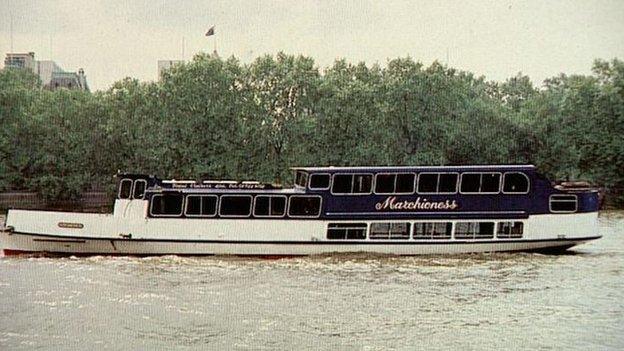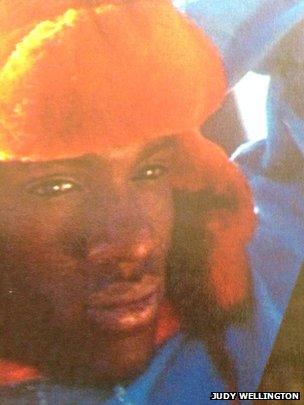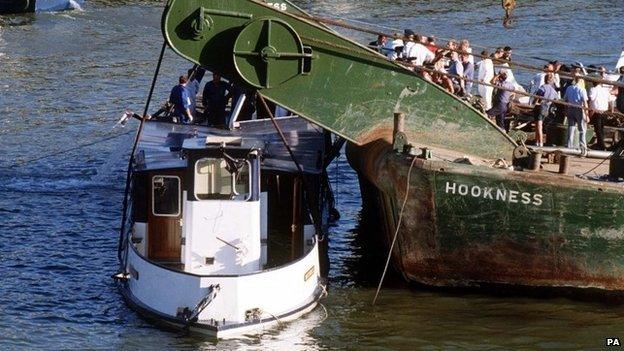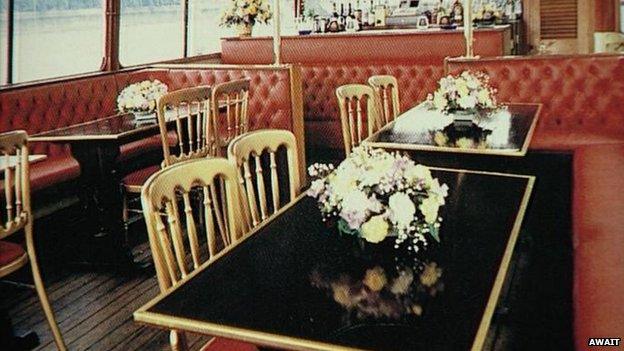Marchioness survivors and victims' families recall Thames disaster
- Published

More than 130 partygoers were on board the Marchioness pleasure boat on the evening of 20 August, 1989
On a hot, late-summer evening in 1989, the Marchioness pleasure boat, packed with more than 130 partygoers, collided with the dredger Bowbelle and sank in the River Thames, killing 51 people. Twenty-five years on, survivors and victims' families recall what happened and the legacy that remains.
"People were just starting to dance," said Iain Philpott, who was a 26-year-old fashion photographer, from Highbury, north London. "We'd been on board for less than 40 minutes."
He and his girlfriend were among the many twenty-somethings who had been invited to the party organised for banker Antonio de Vasconcellos' 26th birthday.
"We were in the lower dining saloon when the dredger struck," he recalls. "Through the window, we could see the water building up as the stern was being pushed.

Twenty-year-old model Simon Senior was among those who died in the disaster
"The lights went out and we knew water had got into the hull," he says. "There were lots of screams and next thing, we were all in the water."
Model Simon Senior, who was 20 years old, was also on board.
Mr Senior modelled for ID magazine, lived with his girlfriend on west London's trendy King's Road and played bass guitar in a band.
"He was creative, artistic and had an amazing sense of humour," says his mother Judy Wellington. "He just cut to the chase and made you laugh in seconds.
"He had this need to be successful. There weren't many black models and he just wanted to be the best."
On board the Marchioness, Mr Senior was with a woman on the dance floor but when the craft crashed they were thrown apart.
He escaped into the river water outside the vessel and started trying to swim to shore but the current was against him.
"Fate was also against them that night," his mother recalls.
Mr Philpott also managed to escape from the vessel into the river.
"I saw an empty barrel of beer coming towards me and grabbed hold of it, then got a few other people to hold on," he said.
The group struggled over to another party boat, were pulled onboard and transferred to Westminster Pier before being taken to hospital.
But Mr Philpott's friends and girlfriend did not survive. "I probably spent a month going to friends' funerals," he said.
Ms Wellington said she found it hard initially to accept her son was dead.

Disaster and aftermath
•On 20 August 1989, 131 people were on board the Marchioness when it was hit by the dredger Bowbelle
•51 people died
•Coroner Dr Paul Knapman decided to cut the hands off more than 20 victims for identification purposes
•A public inquiry in 2000 said poor lookouts on both vessels were responsible for the collision
•The captain of the Bowbelle, Douglas Henderson, had drunk six pints of lager on afternoon of the accident
•The Metropolitan Police were "ill-prepared" and had no contingency plan for such an event, the inquiry found
•January 2002, Royal National Lifeboat Institution introduces four lifeboat stations on the River Thames

"All I kept thinking was my child is somewhere but I couldn't reach him," she said. "I couldn't eat or sleep and when I did sleep, I'd wake up and that feeling of pain would come back inside of me.
"Then I started to realise he was not coming back."
A few days later, a body matching Mr Senior's description was found in the river near HMS Belfast.
"Losing him tore out my heart," she said. "My world fell apart. I felt helpless, went into shock and couldn't move."
As if the pain of mourning friends was not bad enough, the months and years that followed the tragedy were to test the survivors and victims' families even more.

The Marchioness collided with the dredger Bowbelle and sank in the River Thames in central London

A total of 51 people were killed in the tragedy
Some of the families had to come to terms with the controversial decision by Westminster Coroner Dr Paul Knapman to cut off the hands of more than 20 of the victims for identification purposes - an action criticised by Lord Justice Clarke in his subsequent 2001 report into the circumstances surrounding the collision.
Ms Wellington said of her son: "He was a brilliant musician. It's unbearable to think they cut his hand off, but nothing was said about it."
Many families threw their efforts into improving safety on the river, frustrated at what they regarded as a lack of government commitment to tackling the issue.
Margaret Lockwood-Croft, whose son Shaun, 26, died in the disaster, was one of the the Marchioness Action Group's founding members.
She proudly lists just some of the achievements of the group's campaigning: the introduction of lifeboats on the River Thames in 2001, new laws on being in charge of vessels under the influence of alcohol, and training for police family liaison officers.

After the Marchioness collided with the 880-tonne dredger, it sank within minutes
"A lot of legacies have come out of the Marchioness disaster so those 51 people, I'm sure in their place of comfort, they are proud something has come out of their deaths," she said.
Meanwhile, Ms Wellington said her son's death had also left a positive legacy.
"Over the years I have decided everything I do has to be in Simon's memory," she said. "In his 20 small years, he had so much desire to do something to change."
After he died, she went to college, gained a degree, then did teacher training and set up a language school.
She now runs the school and works with young people in community development.
"I changed my life so I could take him with me," she said. "I feel his legacy has lived on."